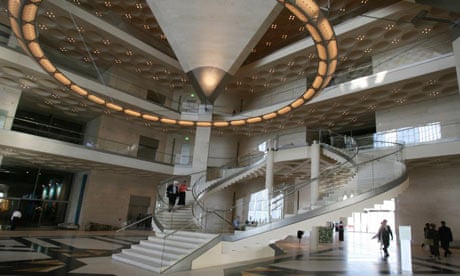The Gulf states are famous for their shopping malls and skyscrapers, but now they are intent on promoting their cultural heritage with an ambitious plan to open a string of museums after Qatar unveiled a spectacular showcase for Islamic art at the weekend.
The collection housed in the Museum of Islamic Art may not be the biggest in the world but it is a contender for being the most impressive.
Built on an artificial island on reclaimed land, the museum, designed by one of the world's leading architects, IM Pei, holds 800 artistic and historical treasures from three continents and illustrates Islamic culture spanning 1,100 years.
The inauguration was attended by heads of state and celebrities, including the Hollywood actor Robert De Niro, who will bring his long-established Tribeca film festival to Qatar next year, it was announced yesterday.
Georgina Adam, from the Art Newspaper, described the museum as "fabulous".
"It's got that Pei finish. It is elegant and simplistic. The display rooms are dark and it is like a treasure chest.
"The collection is very good and for one that was assembled so rapidly it is remarkable," she said.
She added that Gulf states were beginning to see culture as a missing part of the puzzle.
"They have the ritzy airports, big towers and financial institutions, but they want to get culture and they're very competitive. Qatar wants to distinguish itself from Dubai, which is seen as brash, and it has got in there first.
"New money does not have art. There was a time when America was new money and it went around buying art. The Russians have done it and so have the Chinese. It is also a question of pride - pride in being Arab."
The oil-rich state has enlisted other top architects - Jean Nouvel and Santiago Calatrava - to design museums for its capital city.
Sheikha al-Mayassa, arts patron and daughter of the emir of Qatar, Sheikh Hamad bin Khalifa al-Thani, told journalists: "We want to show that Islam is a peaceful civilisation, which has always called for tolerance and coexistence among different peoples."
Her mother, Sheikha Mozah Bint Nasser al-Missned, is also helping to promote Qatar as a cultural destination by opening an Arab Museum for Modern Art.
It will give an overview of contemporary artistic genres in the Arab world, bringing together the works of the Maghreb Arabs of north-west Africa alongside those of the Mashriq eastern Arabs, and will comprise more than 5,000 paintings. There will be a special section featuring Arabic calligraphy and more than 700 antiques, sculptures, ceramics amd metalwork representing the civilisations of Mesopotamia, Arabia, Greater Syria, Egypt and other areas.
John Martin, director of contemporary art fair Art Dubai, the biggest event of its kind in the Middle East, said the Gulf was inventing itself as a home for Islamic art.
"Doha and Dubai represent a new type of city and culture, they don't have the cultural baggage," he said.
"Nobody has written any rules and anything can happen."
Sheikh who shopped
The Islamic Museum of Art might never have opened were it not for Sheikh Saud Al-Thani, the former chairman of Qatar's National Council for Culture, Arts and Heritage, whose billion-pound shopping spree led to his arrest, downfall and omission from recent coverage about the museum. From the late 90s until 2004 Al-Thani, who is second cousin of the ruling emir, was one of the biggest buyers in the world, paying record prices for art and objects that would fill five new museums as part of an ambitious plan to transform Qatar into the cultural capital of the Gulf. In a single week he once parted with £15m. Al-Thani scooped up photography and antiquities worth millions, including 1,000 antique bicycles and hundreds of vintage cars. But his greatest passion was Islamic art and it is likely that he purchased many of the highlights featured in the new museum. His buying power ran out in 2005, when he was arrested on suspicion of misusing almost £300m of public funds and lost his position as council chairman. It is believed Al-Thani was pardoned.
